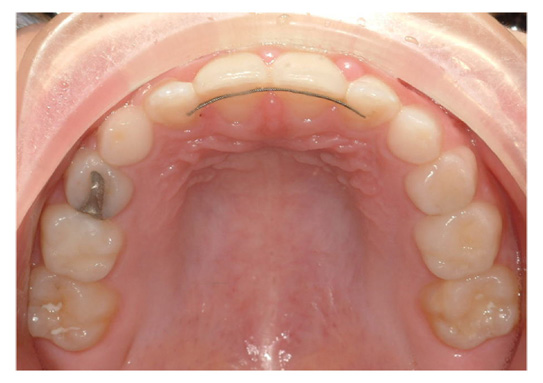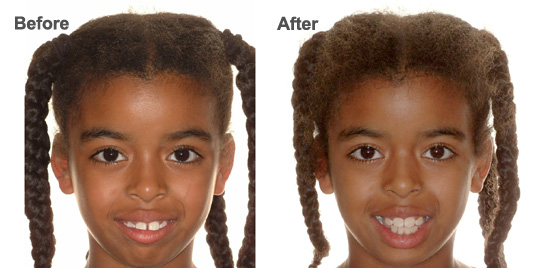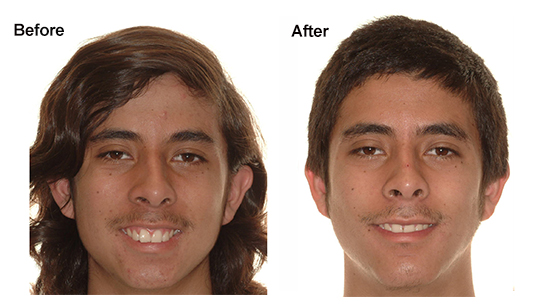January 19th, 2016

A GAP BETWEEN YOUR seven year old's front teeth may look cute at 7, but unless you're Madonna, it may not be wanted in adolescence or adulthood. To prepare for your child's future, many 7 year olds have their gap closed by orthodontic treatment.

A gap, or diastema, is common at age 7 when half baby teeth and half permanent teeth are present. Orthodontic treatment at age 7 is called Phase 1 Orthodontic Treatment. It is treatment of half permanent teeth. Additional Phase 2 treatment of all permanent teeth may be needed at age 12.
If a diastema is larger than 2mm, it will not close on it's own. Your orthodontist can help to close this space and get your 7 year old's teeth looking beautiful.

A diastema is often caused by a thick frenum, a piece of skin between the front teeth. Frenums are often hereditary in families. The frenum is best removed once the diastema is closed. The space will be held closed by a wire on the back side of the front teeth.

A periodontist, or gum specialist, will remove your child's frenum to make space closure permanent. Frenum removal is done AFTER the space is closed by your orthodontist.

If you have questions about your child's diastema or frenum, Orthodontist Dr. Ann Marie Gorczyca and Gorczyca Orthodontics can help. Call us at (925) 757-9000 or visit us at www.clubbraces.com.
Goodbaye Gap! Hello happiness! Here's to looking at your 7 year old's beautiful face, teeth, and smile!
Tags: Antioch, orthodontist, dentistry, orthodontics, braces, dental, Moms, seven year olds, Phase 1 braces, fixed retainer, children, kids, parents, parenting, mums, diastema, gap, lingual retainer, pediatric dentistry, pediatrics, Phase 2 braces
Posted in Blog | No Comments
October 23rd, 2015

YOU NEVER GET a second chance to make a good first impression. Many young people say braces were the best thing that ever happened to them. Many parents report that braces had a very positive impact on their child's confidence and self-esteem. Who doesn't want to look and feel their best?
A Smile Can Affect All Aspects Of Your Life
Parents: your child's smile will affect how they feel, who they date, who they marry, what type of job they get, and ultimately how successful they may be in life. That's why at Gorczyca Orthodontics, we are passionate about giving young people the orthodontic treatment they need for the happiest and most successful life possible.

Dr. Gorczyca has over 25 years of orthodontic experience and our professional team has over 100 combined years of knowledge in delivering orthodontic satisfaction . We have treated over 10,000 happy patients. We understand what your child's straight teeth mean to them and to you.


We Help Create Happy And Healthy Smiles
Advanced orthodontics can give your child amazing results. We create a personalized orthodontic solution to your child's unique needs. Call us today at (925) 757-9000 or visit us at www.clubbraces.com to schedule your child's complimentary orthodontic evaluation.

Parents: whatever your child's orthodontic needs, we're here to help. You will be very happy with the way your child looks after orthodontic treatment. People's reaction to your child's smile will be beyond positive and everyone will feel great.
July 7th, 2015

DENTAL AND SKELETAL bite problems are evident by age 7. Phase I Phase II orthodontic treatment is like doing half now, half later, assisting you with the development of your smile from age 7 to age 13 when your smile is mature.
Phase I orthodontic treatment starts around age 7 in the mixed dentition when 12 permanent teeth and 12 baby teeth are present.

Phase I Phase II Treatment May Improve Your Final Result
In 15% of cases, the overall result will be improved by Phase I orthodontic treatment. Benefits include symmetrical jaw growth, eliminating the need for tooth extraction, preventing tooth wear, or stopping harmful habits such as thumbsucking while improving speech and self-esteem.

Permanent retainers are popular after Phase I orthodontic treatment. These bonded wires prevent tooth relapse and the need for replacement of lost retainers.
Sixteen permanent teeth come in between Phase I and Phase II orthodontic treatment. The chances of one of these new teeth being crooked is high. Usualy there is a benefit in doing Phase II orthodontic treatment after Phase I treatment.
Phase I Treatment Makes Phase II Go Easier

Phase II orthodontic treatment begins when all the permanent teeth have come into place at age 12.
Phase II treatment is easier because Phase I treatment has already corrected the major orthodontic problems.

If you have questions about Phase I Phase II orthodontic treatment, visit us at Gorczyca Orthodontics www.clubbraces.com or call us at (925) 757-9000 for a complimentary consultation.
Every smile is unique. Here’s to the growth and development of your beautiful smile!
Tags: Antioch, orthodontist, dentistry, braces, Gorczyca Orthodontics, Dr. Ann Marie Gorczyca, early braces, Phase I, age 7, children, growth and development, mixed dentition, Phase II, kids
Posted in Blog | No Comments






















